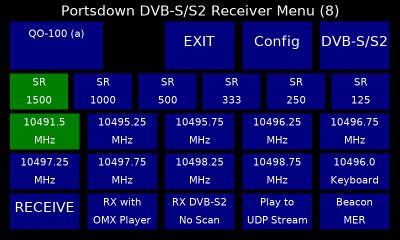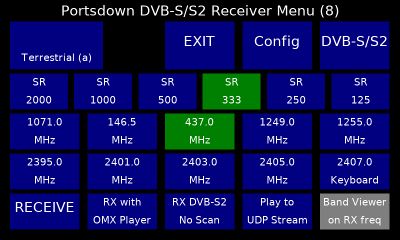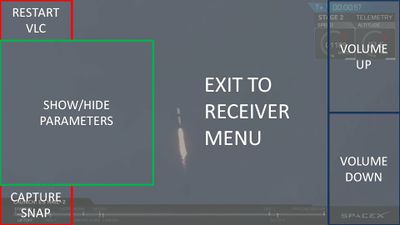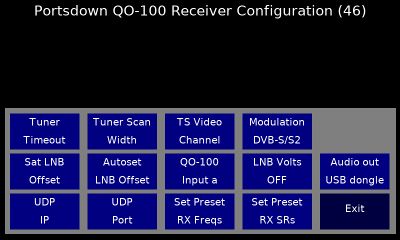Difference between revisions of "DVB-S/S2 Reception"
| Line 60: | Line 60: | ||
In "RECEIVE" and "RX DVB-S2 No Scan" modes, the VLC player can be restarted by touching the top left corner of the touchscreen, as shown on the touchmap above. After this restart, the parameter overlay will be displayed continuously. This function can be useful if VLC seems to "lock up" after receiving a corrupt signal. | In "RECEIVE" and "RX DVB-S2 No Scan" modes, the VLC player can be restarted by touching the top left corner of the touchscreen, as shown on the touchmap above. After this restart, the parameter overlay will be displayed continuously. This function can be useful if VLC seems to "lock up" after receiving a corrupt signal. | ||
| + | |||
[[File:menu46.jpg|400px]] | [[File:menu46.jpg|400px]] | ||
Revision as of 21:16, 5 September 2021
The Portsdown will work with the BATC Version 2 MiniTiouner (using the Serit FTS-4334 and FTS-4335 tuners only) to receive DVB-S and DVB-S2 signals over the frequency range 144 MHz to 2450 MHz. The receive symbol rate is limited to the range 66 kS to about 5 MS; reception at below 66 kS is not currently possible.
The receive functionality was recently enhanced in the Portsdown 4 update 202108011. The capability is described here.
QO-100 or Terrestrial?
The receiver has 2 sets of presets; one for QO-100 and another for terrestrial. Most receiver parameters are also stored separately for each of these bands. You can switch between bands using the top left button on the receiver screen. The Configuration Menu title also shows which band you are setting the parameters for.
Receive Modes
There are now 4 receive modes. Each uses a different receive mode or video player.
RECEIVE
The button labelled "RECEIVE" starts the receiver scanning in Cold Start (Zero Offset) mode with a known SR, but an unknown frequency. The receiver will scan for DVB-S and DVB-S2 signals around the set frequency, with the scan limited by a percentage of the set SR. This percentage can be set using the "Tuner Scan Width" button on the Configuration Menu.
For example, if the receiver is set to 437 MHz and SR 250 with the default Scan Width of 50%, it will search from 436.875 MHz to 437.125 MHz.
If a valid DATV signal is found, it will be played on the Portsdown screen using VLC with the ffmpeg option enabled.
RX with OMX Player
The button labelled "RX with OMX Player" uses exactly the same receiver search parameters as "RECEIVE", but uses the OMX Player video player.
OMX Player cannot display H265 signals (or some H264 signals, such as the QO-100 beacon), and has no parameter overlay available. This option is soon to be discontinued as the author of OMX Player is ceasing support for it in favour of VLC.
RX DVB-S2 No Scan
The button labelled "RX DVB-S2 No Scan" starts the receiver scanning in Warm Start (Zero Offset) mode for a DVB-S2 signal with known SR and frequency. In practice, the frequency scan is about 10% of the SR, and the "Tuner Scan Width" setting has no effect. This setting is ideal for the reception of weak DATV signals, especially in the presence of adjacent channel interference.
If a valid DVB-S2 (only) DATV signal is found, it will be played on the Portsdown screen using VLC with the ffmpeg option enabled.
Play to UDP Stream
The button labelled "Play to UDP Stream" uses exactly the same receiver search parameters as "RECEIVE", but sends the received transport stream to the UDP address and port set in the Configuration Menu.
The Portsdown screen displays the received MER in large numbers when this mode is selected.
SCAN TIMEOUT TIME
The length of time that the tuner scans without resetting itself (if no signal is found) can be set using the "Tuner Timeout" button on the Configuration Menu. The default for QO-100 is 5000 mS (5 seconds), but this is doubled at 250 kS and quadrupled at 125 kS to allow for longer lock times.
The default for terrestrial reception is -1, which disables the tuner timeout.
RF Input Level Indication
The RF Input Level displayed on the parameter overlay is an indication of how much RF Power is being sensed by the tuner in a 10 MHz bandwidth around the current selected frequency. As such, it is useless for peaking signals, but provides a very good indication of whether the MiniTiouner is operating with the optimum input signal level. The indication should be above -70 dB and below -35 dB of optimum results. Input levels of below -70 dB are displayed in red to indicate that there might be a problem. A fuller description is provided here: MiniTiouner_Power_Level_Indication.
Volume Control
The audio level output from VLC can be controlled by touching the upper and lower regions of the right hand side of the screen as shown on the touchmap:
The audi level is set in 11 steps indicated as between 0 and 100%. The audio setting is persistent between reboots, but only affects VLC, not any other of the system media players.
Video Player (VLC) Restart
In "RECEIVE" and "RX DVB-S2 No Scan" modes, the VLC player can be restarted by touching the top left corner of the touchscreen, as shown on the touchmap above. After this restart, the parameter overlay will be displayed continuously. This function can be useful if VLC seems to "lock up" after receiving a corrupt signal.
Special QO-100 Functions
Dish Alignment. When QO-100 is selected, the bottom right button allows the display of the QO-100 Beacon received MER in large numbers, with a green/red bar on the right hand side to indicate an increase or decrease in MER sunce the function was selected. This display is specifically designed for QO-100 dish alignement.
LNB Offset Calculation. For LNBs with a local oscialltor of around 9750 MHz, the "Autoset LNB Offset" button on the Receiver Configuration Menu can be used to automatically store the exact current LNB local osciallator frequency.
Special Terrestrial Functions
When Terrestrial is selected (and a LimeSDR Mini is connected), the bottom right button allows direct exit to the BandViower with it tuned to the current receive frequency.
Input Port and Voltage Selection
The tuner input port (A = upper, B = lower) can be selected from the Configuration Menu. This setting is stored independently for QO-100 and Terrrestrial.
If the correct hardware is fitted to your tuner, the LNB Voltage can also be set from the Configuration Menu (agauin independently between QO-100 and terrestrial).



